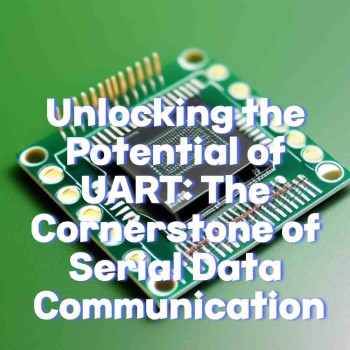What is UART?
- UART is a Universal Asynchronous Receiver Transmitter.
- UART is a simple physical circuit used in Microcontroller.
- The only purpose of UART is to receive and transmit serial data.
- I2C and SPI are synchronous and have a clock. But there is no clock involved in UART.
Process of establishing UART Protocol :
- The communication occurs between two devices say UART 1 and UART 2.
- Tx of UART 1 sends a data packet to Rx of UART 2. While receiving, Tx of UART 2 sends a data packet to Rx of UART 1.
- The serial data transfer occurs in the packet format.
- There is no clock involved for synchronizing during the communication process.
- The Data Packet comprises the following –
- Start Bit
- Data Frame
- Parity Bit
- Stop Bit
- The actual data that needs to be transferred is the “Data Frame.”
- UART 1 accepts data in a parallel manner. It keeps LSB (Least Significant Bit) as the first bit in the data frame.
- Under normal conditions, the bus is at a HIGH voltage level. Therefore, when the first bit of data is about to start, then for the start bit, one bit is made LOW i.e. from HIGH to LOW for that respective one cycle. Therefore, whatever after this start bit is nothing but Data Bits.
- Stop Bit is normally HIGH.
- UART 2 receives the data packet. It also reads the data packet.
- UART 2 checks parity. Say if a number of 1s is even and the parity bit is 0 then UART 2 concludes it can move forward, and after the Stop Bit it stops.
- Parity Bit is optional.
- If the Parity Bit is 0 i.e., the Number of 1s in the respective Data Frame are Even.
- If the Parity Bit is 1 i.e. Number of 1s in the respective Data Frame is Odd.
- UART 1 sends the data serially and receives the data In a parallel manner. Therefore, Start Bit, Parity Bit, and Stop Bits are added along with data.
- UART sends data in a parallel manner. UART 2 sends the data further.
- Before this Start bit, the Parity Bit and Stop Bits are removed.
Advantages And Limitations :
Advantages:-
- Simplicity: UART is a common choice for device communication since it is straightforward to use and comprehend.
- Low Overhead: Due to the fact that UART only needs a start bit, data bits, an optional parity bit, and stop bit(s), it has a low overhead. As a result, data transmission across serial connections is effective.
- Flexible Baud Rates: The data transfer speed in the UART connection can be easily adjusted based on the needs of each device and the communication environment by changing the baud rate.
- Half Duplex and Full Duplex: UART can support both half-duplex (bidirectional communication, but not simultaneously) and full-duplex (simultaneous bidirectional communication) modes, providing flexibility in communication setups.
- Real-Time Communication: Since there is little lag between sending and receiving data, UART can be used for real-time communication.
Limitations:-
- Speed Limitations: While UART allows for flexible baud rate settings, it might not be suitable for very high-speed communication due to the limitations of the asynchronous nature of the protocol.
- No Acknowledgement: Built-in data receipt acknowledgment is not a feature of UART. If there is no way to confirm that the data was successfully transmitted, this could result in data loss or inaccuracies.
- Lack of Error Checking: Built-in error-checking methods are absent from UART. Parity bits can be used for simple error detection, but UART does not include built-in capabilities for advanced error checking and correction.
- Protocol Overhead: UART has a relatively high protocol overhead due to the start and stop bits, which can be inefficient for sending small amounts of data.
- Asynchronous Communication: Synchronous data transfer—where a clock signal is sent together with the data—might be more suitable for some applications despite the fact that UART is recognized for asynchronous communication.
Applications Of UART Protocol :
- Embedded Systems: UART is widely used for communication between microcontrollers, sensors, and peripheral devices within embedded systems.
- Wireless Communication Modules: UART is used to communicate with wireless modules like Bluetooth, Wi-Fi, and Zigbee modules, enabling these devices to exchange data wirelessly.
- Industrial Automation: UART is used in industrial automation systems to communicate between PLCs (Programmable Logic Controllers), sensors, actuators, and other control elements.
- Automotive Electronics: UART is utilized in automotive systems for communication between different electronic control units (ECUs) and sensors within a vehicle.
- Medical Devices: UART is used for data interchange and control in a variety of medical devices, including patient monitors, medical imaging equipment, and diagnostic instruments.
- GPS Tracking Devices: GPS tracking systems employ UART to transmit and receive commands and location data for in-the-moment tracking and monitoring.
More Communication Protocol Posts:

